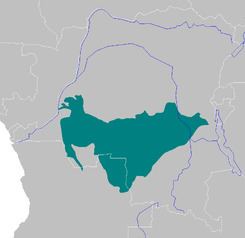 | ||
The southern congolian forest-savanna mosaic covers a large area of the southern Democratic Republic of the Congo. Many African elephants are found in this forest including a number of different species. Its rich blend of habitats provides key insights into the biogeography of central Africa with the extensive climatic variation that it has been experiencing for the last 10 million years. The human population is not high. There is only one secured area in this ecoregion. The political situation in the Democratic Republic of the Congo is unstable; until the country is stable, no important conservation work is possible.
Central Africa is familiar with repeated climatic variation that have caused rain forest and savanna expansion and deflation in consideration of the late Pleistocene tectonics defined the Congo Basin. Important climatic shifts have occurred more than 20 times in less than 10 million years. Plants and animals adapt, change, and go extinct with any climatic oscillation. Widespread and immensely resilient organisms that lived through in islands of habitat and accustomed to spatial fluidity were favored. During dry periods, savanna communities breached far into the Congo Basin. The relatively moist riparian forests become detached from one another and compose forest island localities in the savanna matrix.
